
|
|
Aspherical lens
 Aspherical lens eliminates image distortion and reduces field curvature
to negligible levels, thus enabling clear, crisp images up to the
periphery of the viewing field.
Aspherical lens eliminates image distortion and reduces field curvature
to negligible levels, thus enabling clear, crisp images up to the
periphery of the viewing field.
Left : Aspherical lens without aberration (undistorted dots)
Right : Spherical lens with aberration (dots are distorted)
|
|
Aberrations
and Distortion
|
|
Binocular types : Prism binoculars
Prism binoculars have a wider field of view and higher magnification
than Galilean binoculars.
Convex lenses are used for both objective and eyepiece lenses.
The inverted image is rectified by prisms in the optical path.
Two types of prism binoculars are available : 1) Roof (Dach) prism
binoculars and 2) Porro prism binoculars.
Roof (Dach) prism binoculars
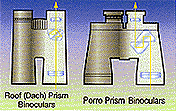 Roof prism binoculars are becoming popular thanks to their light
weight and compact size.
Roof prism binoculars are becoming popular thanks to their light
weight and compact size.
Since production and adjustment of roof prisms require the highest
level of precision, optical performance differs from maker to maker.
"Roof" refers to the roof-like shape of the prism. While, "Dach"
is taken from the German word for "roof. "
Porro prism binoculars
The "Porro prism" was invented by an Italian engineer, Ignazio PORRO,
in 1875. It is widely used in binoculars today.
Porro prism binoculars have a simple, rugged construction and form
bright images.
Non - prism binoculars
Galilean binoculars
 Generally known as opera glasses, "Galilean binoculars" were named
after their inventor, Galileo GALILEI (1564~1642) , the ltalian
astronomer. These binoculars consist of convex lenses for the objectives
and concave lenses for the eyepieces ; they form upright images.
With a simplified prism - less optical system, Galilean binoculars
feature neither high magnification nor a wide field of view.
Generally known as opera glasses, "Galilean binoculars" were named
after their inventor, Galileo GALILEI (1564~1642) , the ltalian
astronomer. These binoculars consist of convex lenses for the objectives
and concave lenses for the eyepieces ; they form upright images.
With a simplified prism - less optical system, Galilean binoculars
feature neither high magnification nor a wide field of view. |
|
Click-type dioptre adjustment ring
 The dioptre adjustment ring, located at the bottom of the right
eyecup is for adjusting the difference in visual acuity between
the left and the right eye.
The dioptre adjustment ring, located at the bottom of the right
eyecup is for adjusting the difference in visual acuity between
the left and the right eye.
The click-type mechanism ensures that the ring remains properly
adjusted at all times.
ex. 0.5 dpt. (dioptre) for each click (TRAVELITE V series)
|
|
Dioptre adjustment ring locking
system
 Nikon's original locking system in the dioptre adjusting
ring keeps the binoculars always adjusted to the user's eyesight
and ready for use at any time.
Nikon's original locking system in the dioptre adjusting
ring keeps the binoculars always adjusted to the user's eyesight
and ready for use at any time.
Left : Dioptre adjustment ring unlocked
Right : Locked
|
|
Durable, shock-resistant structure
Nikon uses quality materials and assembly methods to minimise
the chance of the optical axis being knocked out of alignment.
If this happens, it can make viewing extremely hard on the eyes
and cause headaches. |
|
ED glass
 Nikon
especially developed ED (Extra-low Dispersion) glass to provide
pricise optical colour correction. Nikon
especially developed ED (Extra-low Dispersion) glass to provide
pricise optical colour correction.
Because colours of the spectrum have differing wavelengths, red
and blue light rays are bent at slightly different angles as they
pass through nomal optical glass.
This dispersion results in colour fringing and lack of sharpness
(see illustration at right).
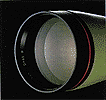 Modern techniques to correct this chromatic aberration are effective
with most lenses.
Modern techniques to correct this chromatic aberration are effective
with most lenses.
But telescopic lenses magnify the slight variation in focus between
red and blue light rays.
Nikon developed ED glass in order to provide the sharp, clear
resolution required for superb photographs. |
|
ISO 9001 spec.
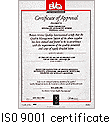 In
1994, we received a prestigious ISO 9001 award in recognition of
excellence in quality control, the first Japanese binocular manufacturer
to be so honored. In
1994, we received a prestigious ISO 9001 award in recognition of
excellence in quality control, the first Japanese binocular manufacturer
to be so honored.
Elaborate care is taken to ensure that each part of the process
from production to shipment and maintenance support is conducted
based on the exacting ISO 9001 quality control system.
Finished products are scrutinized with a fine comb.
These inspections guarantee that Nikon binoculars will provide
precise performance and smooth operation for years to come. |
|
Long eye relief (High
eyepoint)
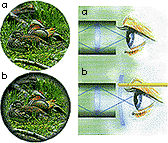 Eye relief is the distance between the eyepiece lenses and the eyepoint
at the time of focusing.
Eye relief is the distance between the eyepiece lenses and the eyepoint
at the time of focusing.
Nikon's long eye relief models ensure comfortable, appropriate
viewing, and make it possible for wearers of glasses to see clearly
up to the periphery.
a) View from eye relief point
b) View out of eye relief point
|
|
Multilayer coating
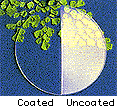 Nikon's multilayer coating prevents the loss of light that
is caused by reflection on a lens surface, thus increasing light
transmittance and offering a brighter, much clearer viewfield.
Nikon's multilayer coating prevents the loss of light that
is caused by reflection on a lens surface, thus increasing light
transmittance and offering a brighter, much clearer viewfield. |
|
Nikon original optical design
| Field of view |
 |
 |
Nikon's advanced computer-calculated design of the complete
optical system minimises aberrations, resulting in higher resolving
power and crisp image definition throughout the viewing field.
As a result, the following is achieved :
1. The whole visual field is sharp.
2. The periphery and centre of the image are focused simultaneously.
3. The image appears undistorted.
4. Colours do not become blurred and real colour is reproduced.
|
|
Nikon's prime optical materials
Nikon uses its own special high-grade optical glass for lenses
and prisms, and subjects it to strict inspection standards based
on years of expertise in glassmaking.
This ensures brighter, clearer images, which means less eye fatigue
even in lowlight settings like concert halls or evening twilight.
|
|
Prism design of Angled type Fieldscopes
 Integrated in the angled body type Fieldscopes, Nikon's advanced
prisms are designed for total light reflection, to ensure extra-bright
viewing and approximately 15% less optical loss when compared with
conventional angled body types having aluminium-coated prisms.
Integrated in the angled body type Fieldscopes, Nikon's advanced
prisms are designed for total light reflection, to ensure extra-bright
viewing and approximately 15% less optical loss when compared with
conventional angled body types having aluminium-coated prisms.
This prism provides angled body scopes with the same brightnass
found in Nikon straight body types. |
|
Rubber-armoured models
This moulded coating provides shock-resistance and a firm, comfortable
grip. |
|
Rubber protein-compound coating
New body material features superior hygroscopic / de-hygroscopic
qualities and protects the binoculars from fingerprints and scratches. |
|
Smooth operation
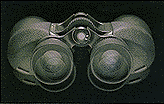 Nikon inspects all materials and uses advanced processing
methods for peak performance.
Nikon inspects all materials and uses advanced processing
methods for peak performance.
All moving parts are lubricated for easy operation in variable-temperature
areas. |
|
Superior prisms for clarity
| Exit pupil |
 |
 |
Nikon makes prisms of the precise design to produce a perfectly
round exit pupil, a sign of good binoculars.
The exit pupil is the bright circle of light seen in the centre
of the eyepiece lens when you hold the binoculars about 30cm (approx.
1 ft.) in front of you pointed toward a light (Don't look at
the sun !) .
Cheap materials and inferior design cause lost light and poorer
image quality. |
|
Technical
checkpoints
|
|
Using
Nikon Binoculars
|
|
Waterproof binoculars
 These models are sealed with O-rings and filled with nitrogen (N2)
gas so that they never fog up.
These models are sealed with O-rings and filled with nitrogen (N2)
gas so that they never fog up.
They are ideal for mountaineering, sailing or any other activities
in severe weather conditions. |
| |

